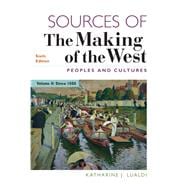Sources of The Making of the West helps bring the history of the west to life. Thoroughly revised and designed to be used independently or as a companion reader, this two volume collection parallels the major topics and themes covered in each chapter of The Making of the West. A broad range of source types and themes illuminate historical experience from a diversity of perspectives. Now with a visual source and a comparative source pairing in every chapter, this reader offers instructors even more opportunities to promote classroom discussion of primary documents and to help students develop essential historical thinking skills.








